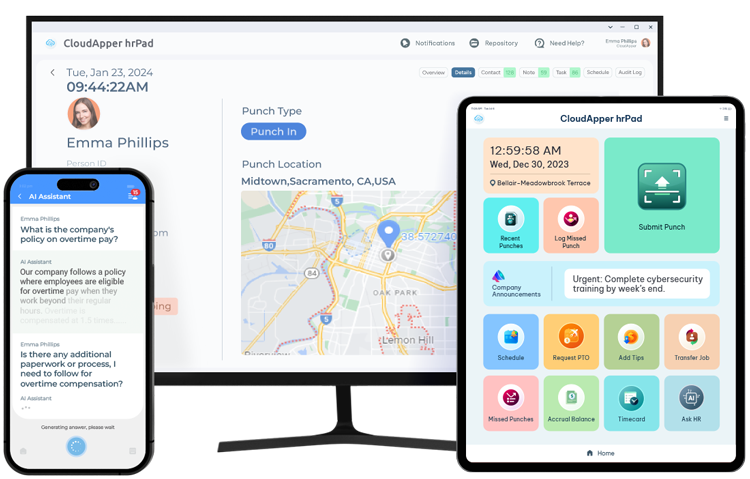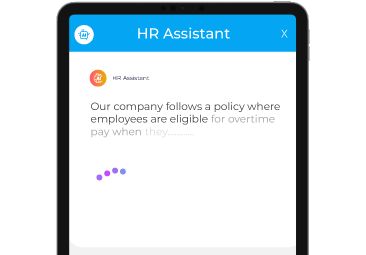Avoiding Costly Child Labor Violations: How Franchises Can Stay Compliant with AI

Recent child labor violations in the fast-food industry, including those involving Burger King and Popeyes franchise operators in Massachusetts, have put a spotlight on the challenges of labor law compliance. With penalties exceeding $2 million and back wages paid for violations, businesses must recognize the growing risk of non-compliance and its financial and reputational consequences.
For franchise operators managing multiple locations, ensuring compliance with labor laws is no small feat. The decentralized nature of these businesses, combined with varying state regulations, creates an environment where mistakes can happen. However, modern HR technology solutions like CloudApper hrPad’s employee self-service kiosk provide a proactive approach to managing compliance, reducing legal risks, and enhancing employee satisfaction.
Understanding the Growing Risk of Child Labor Violations
According to a report by the U.S. Department of Labor, child labor violations have increased by over 37% since 2020. Many of these violations stem from unintentional errors, such as failing to monitor minors’ work hours or assigning them tasks beyond their legal limits. Franchises, with their large workforce and multiple locations, are particularly vulnerable to such infractions. The consequences can be severe, leading to substantial fines, lawsuits, and reputational damage that can impact long-term business success.
How CloudApper hrPad Helps Franchises Stay Compliant
The hrPad employee self-service kiosk is a powerful tool designed to ensure compliance with labor laws while streamlining HR processes. Here’s how it can help franchise operators prevent child labor violations:

1. Automated Compliance with State-Specific Labor Laws
Labor laws vary across states, making it difficult for businesses to track regulations in multiple locations. hrPad can be customized to align with each state’s specific child labor laws, automatically flagging any violations before they occur. If a minor attempts to clock in beyond permitted hours or is scheduled for overtime, hrPad will notify both the employee and management, preventing costly errors in real-time.
2. Real-Time Alerts and Monitoring
Unlike traditional time-tracking methods, hrPad actively monitors employee work hours. It sends real-time alerts if a minor exceeds their legally allowed working hours, helping managers intervene immediately. This feature ensures compliance, even in fast-paced environments like quick-service restaurants, where scheduling oversights are common.
3. Geofencing to Enforce Legal Work Hours
With geofencing technology, hrPad ensures that employees can only clock in and out when physically present at their designated work location. This feature prevents minors from working outside their permitted hours, regardless of location-specific labor laws. For franchises with locations across different states, this ensures uniform compliance and eliminates potential violations.
4. AI HR Assistance for Legal Guidance
hrPad’s AI HR assistant is available 24/7 to provide instant answers to employees regarding labor laws and work restrictions. Younger workers can easily access information about their rights, shift limitations, and overtime rules, promoting awareness and proactive compliance. This feature empowers both employees and managers with the knowledge needed to avoid violations.

A Real-World Example: Protecting Franchise Operators
Consider a fast-food franchise with multiple locations spanning several states. By implementing hrPad, each site can be configured to automatically enforce labor laws specific to its jurisdiction. The kiosk will:
- Notify managers if minors are scheduled for overtime.
- Prevent clock-ins beyond legally permitted hours.
- Track all work hours in real-time for audit purposes.
As a result, the franchise can avoid hefty penalties, ensure compliance, and maintain a transparent and fair work environment for all employees.
The Business Benefits of Proactive Compliance
Beyond legal compliance, adopting smart HR technology like hrPad offers additional benefits, including:
- Reduced HR Workload: Automating compliance checks frees HR teams from manual monitoring.
- Improved Employee Experience: Employees can easily access their schedules, request time off, and receive instant HR assistance.
- Cost Savings: Avoiding fines and lawsuits saves businesses significant financial resources while improving operational efficiency.
Take Action Before It’s Too Late
As child labor violations continue to rise, businesses cannot afford to take a reactive approach. Implementing CloudApper hrPad’s employee self-service kiosk ensures franchises stay compliant, reduce legal risks, and foster a workplace culture of trust and transparency. Don’t wait for an investigation—take control of labor law compliance today.
Contact us to learn how hrPad can help your business stay compliant and efficient.














